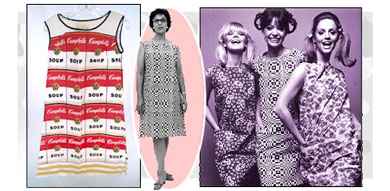Paper dresses

Fashion Synopsis
“Created to make you the conversation piece at parties. Smashingly different at dances or perfectly packaged at picnics. Wear it anytime...anywhere. Won't last forever...who cares? Wear it for kicks—then give it the air.” - Scott Paper Co. advertisement, 1966
Forget about sinking a week's hard-earned wages into the perfect dress that you'll only wear once for the next Factory party. Slip into the cheap, eye-catching and completely tossable novelty: the paper dress. Dressing was never so carefree.
The technologically-savvy 60’s turned us into a throwaway nation. We had disposable plastic plates, bottles, diapers, cutlery, and with the advent of the new paper dresses, even a wardrobe that could be chucked into the garbage after it was used. Architect Buckminster Fuller had even constructed the Geodesic dome, the first paper house. (Where's the big bad wolf when you need him?)
In 1966, Scott Paper Co. turned a simple advertising gimmick into the hottest fashion must-have of the year. Scott offered a paper dress, the ‘Paper Caper,’ as a promotional item with their new ‘Color Explosion’ line of toilet paper and paper towels. For $1.25, Scott sold a simple A-line dress in either a psychedelic paisley or op-art plaid print, made out of a special, sturdy fiber paper. Yes, for only $1.25, you could have a dress that was essentially like a giant handi-wipe towel.
Scott never imagined the extent of the hysteria for the paper dress, and in just six months, half a million dresses were sold. Unable to keep up with production, and coasting on the most successful advertising gimmick of the decade, Scott sold the rights to the paper dress to a line of salivating entrepreneurs.
NASA had created paper clothing in 1962 for its astronauts: the disposable duds made sense miles up in the atmosphere. They were cheap, lightweight, and if they got dirty, just ball them up and toss them out the hatch (this was before ‘biodegrade’ and ‘recycle’ became household words). Scott’s version was touted as reusable for about a week before it would fall apart, and if pieces got dirty, just snip off the stained parts for a whole new look. This way dresses could become tops or skirts, with the help of scissors and an imagination. There was only one major downfall: the dress would catch fire if one got too close to the barbecue grill.
A little fire never scared the industrial society of the day, and soon the paper dress was being treated with a fire retardant spray. The paper apparel market was back in business, and everyone wanted in on the action: Breck shampoo, Betty Crocker potatoes, Johnston frozen pies, and even butter packages offered paper dress coupons. A paper ‘fur’ coat was available for only $250, and if it some of the ‘fur’ got dirty, don’t worry about cleaning it…just cut out the dirty parts! Even U.S. Presidential candidate Richard Nixon wooed female supporters with Nixon printed paper dresses.
Paper apparel was being touted as the next wave of fashion. It was inexpensive, quick to make, and was tons of fun. Plain dresses were sold with crayons for the artistically adventurous to design their own dresses, and Hallmark sold a party pack of paper cups, paper plates and a matching dress for the hostess. And if the kids spilled punch on the floor, you could clean it up with your skirt.
Dupont further advanced the science of paper construction, creating a durable bonded synthetic fiber paper product that would be an early form of the miraculous modern Tyvek (of which there are paper dresses made today). This product could get wet, endure activity, and didn’t fall apart. Hotels offered their guests disposable paper swimsuits, usable for a short stay and guaranteed to hold up in the swimming pool.
Paper clothing was totally egalitarian, and could easily be personalized with pictures or a company’s logo. A New York City boutique called Indispensable Disposables sold nothing but paper clothing and accessories. Even renowned pop artist Andy Warhol got into the action with his ‘souper’ dress of printed Campbell’s soup cans.
The world was enjoying the freedom of a completely disposable society…until the dawn of the hippies. The hippies returned to nature, shunning the space-age technology of the industrial world. They were concerned with the outrageous amounts of garbage piling up on our Earth, and rejected the throwaway beliefs. Recycling became the new craze, along with wearing used, ‘vintage’ clothing. Throwaway paper clothing suddenly didn't seem as attractive, and certainly not ‘Earth-friendly.’
Some garments, like hospital gowns and surgical scrubs, are still made of paper, but the paper clothing industry never replaced traditional materials they way future-thinkers believed. After the 60's, the paper craze fell apart. Paper proved to be too fragile, too inconvenient, and, well, too trendy to last.
